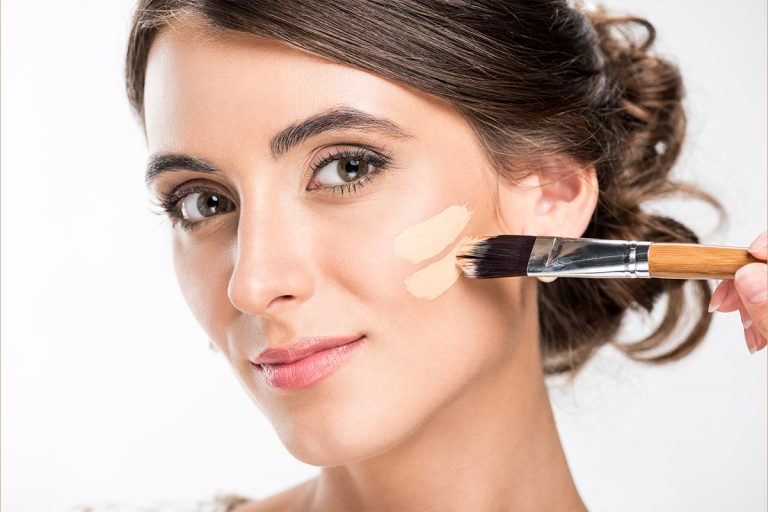Skin Type Matters
Understanding your skin type and undertone is one of the most important aspects of choosing the perfect foundation. Without taking your skin type and undertone into account, you risk encountering an array of issues like clogged pores, acne outbreaks, and flakiness.
To determine your skin type and undertone, it’s best to start with bare skin. Wash your face with a mild cleanser and wait an hour before checking your skin in the mirror. If your skin feels tight and looks glossy and warm, you most likely have oily skin with warm undertone. If it appears and feels dry and cool, you have dry skin with cool undertone. Combination skin is characterised by a T-zone that is shiny and has visible pores but is dry or normal elsewhere with neutral undertone. Normal skin looks naturally flawless and healthy with neutral undertone as well.
Once you know your skin type and undertone, you can choose the right foundation to suit your complexion and address your skin’s concerns. For virtual try on tools, you can find them online to help you see the effects of different foundations on your skin type and undertone. Dewy foundation with a moisturising finish works well for dry skin, while oil-free liquid foundations are recommended for oily skin to prevent excess oil and shine.
Those with combination skin should opt for an oil-free foundation offering light coverage that helps control shine in the T-zone. When dealing with dry skin, it’s essential to choose moisturising foundation products that will not exacerbate flakiness or make acne scars more noticeable. Moreover, using an oil-free makeup remover before applying your foundation will help prevent clogged pores. To achieve a smooth, long-lasting makeup look, it’s also important to use an oil-free and foundation-compatible primer that addresses your skin’s issues, whether that is hydration, pore reduction, or redness reduction. Investing in top-notch oil-free products goes a long way in accentuating your inherent beauty.
Understanding Undertones
Understanding how to choose the best foundation requires an awareness of undertones, which are essentially the colors that lie beneath the surface of your own skin. To ensure a natural blend, it’s critical to first determine your undertones and match your foundation to your skin color. Makeup experts advise paying great attention to the veins on the inside of your wrist because they can give you a good indicator of what undertones you have, whether warm or cool. If you have warm undertones and sensitive skin, a mineral foundation suits your needs perfectly, keeping your skin free from irritation.
To find the perfect shade of foundation, think about how your own skin responds to the sun. Using a moisturizing foundation is a great option for a more polished look, especially if you have older skin. Different brands may have varying undertones, so it’s crucial to test out at least two foundation shades to find the right match for you. If you have oily skin, choosing an oil-free matte foundation in a shade that complements your undertones will help absorb oil and keep your face appearing fresh all day. When selecting an oil-free foundation, it’s important to keep in mind that fluorescent lighting can change your complexion, so it’s recommended to test out several foundation shades in natural daylight. Lastly, to avoid looking overly orange after applying a fake tan, selecting a foundation color that is one shade darker than your natural skin tone is preferable. If you’re not sure where to begin, think about going to a department store where a cosmetic artist may assist you in finding the ideal match.
Coverage Needs
It’s crucial to keep in mind when choosing a foundation that getting a foundation that matches your natural skin tone is essential to avoid looking unnatural. Full-coverage foundations, on the other hand, are the best option for persons with substantial skin flaws that need to be concealed.
These products provide total concealment, which can help you even out your skin tone and produce a faultless finish ideal for special events. Understanding your coverage needs and picking a foundation that suits the texture of your skin will help you attain the optimal, natural-looking complexion among the many foundation alternatives available.
Texture Matters Too
There are several considerations to make when choosing the best foundation for your flawless skin. One of the most crucial elements to take into account is texture, even though many people concentrate on selecting the ideal colour that complements your skin tone and coverage level. It’s crucial to select a foundation based on its texture that suits both your skin type and your tastes because texture can significantly affect how your foundation appears and feels on your skin.
Your skin type is the first thing to take into account. A moisturising powder foundation with neutral undertones is a great option if you have dry skin because it will add the required moisture without drawing attention to any flaky patches. Matte foundations or full coverage foundations without oils will do wonders to manage excess oil and shine for people with oily skin. It’s time to think about coverage after you’ve whittled down your options depending on your skin type and the ideal hue for your skin tone. Go for a sheer or lightweight composition if you want a light covering. But, a thicker and more buildable formula is the way to go if you want more coverage.
Consider your daily activities and how long you need your foundation to last before you consider anything else. A formula that is long-wearing and transfer-resistant is essential if you plan to be active all day. But, a tinted moisturiser or BB cream with a light texture and the appropriate shade will give you the ideal touch of coverage if you’re going for a more natural appearance for informal situations.
In the end, you want to eliminate options that don’t suit your preferences or are the wrong hue and instead choose a texture that is cosy and draws attention to your natural characteristics. You’ll be well on your way to discovering the ideal foundation texture for your skin if you keep these suggestions in mind.
Shade Matching Tips
Although finding the perfect shade for your foundation may seem difficult, it’s a simple task when you have the right advice and information at your fingertips. The first step is determining your skin’s undertone – are you warm or cool toned? Warm-toned individuals typically have yellow or golden undertones, while cool-toned individuals have pink or blue undertones. Once you know your undertone, you can choose a foundation that matches your skin tone perfectly. With so many shades available now, it’s important to remember that what works for one person may not work for another.

To ensure a flawless and natural look, try finding foundation matches by testing it on your chest or neck. Take into consideration the season as well; in the summer, you may need a darker shade, while in the winter, a lighter shade may be desired. When selecting your foundation, it’s important to consider the type of formula you want to use. You may prefer an oil-free liquid or powder for perfect skin. Keep in mind finding the right match may take some time and patience, but with trial and error, you’ll find it. Once you do, your skin will be radiant and beautiful.
Application Techniques
To start your foundation application journey, it is crucial to opt for the best shade that matches your naked skin tones. Thanks to technology, we have virtual try-on tools that allow us to test out different shades before purchasing sheer foundation. Once you have selected the right shade, it’s time to consider the application techniques.
Cream foundations, especially those that enhance your skin’s texture, can be applied with different methods. If you prefer control over coverage, use your fingers, but remember to wash them before application to prevent transferring oil to the face. For those who want equal coverage, use a brush. Powder foundations are also a great option for those who prefer a more matte finish.
On the other hand, a beauty blender sponge will give you an airbrushed finish with cream foundations. Before applying, make sure you moisturize your skin and let it absorb the cream completely. Start blending the foundation from the center of the face to achieve a natural look, patting it instead of rubbing to avoid streaks or lines. Remember to use a small amount of foundation initially and build up coverage as needed to prevent caking or creasing.
By selecting the right application method and an oil-free liquid foundation or cream foundation that matches your cool undertones, you can achieve a natural-looking finish that will last all day.
Choosing the Right Formula
The ideal foundation shade must be chosen, but the proper formula must also be chosen. An oil-free liquid or matte finish foundation with salicylic acid offers complete coverage and manages excess oil for people with oily skin types.
A powder foundation that is moisturising and provides the complexion a dewy sheen will be beneficial for people with dry skin. A water-based product that balances oily and dry areas is necessary for combination skin types. A liquid consistency is best for medium coverage foundations, which give off a natural, second-skin appearance.
For longer-lasting coverage and to cover flaws, full-coverage foundations need a thicker formula. Seek for a foundation that has skincare advantages like antioxidants, UV protection, and anti-aging qualities. Choose the optimal application technique for the best effects when selecting between cream, stick, or powder forms.
To get a flawless complexion, your foundation should have the ideal formula, coverage, and application technique.
Long-wearing or Not?
Given that oils in the skin can hasten the breakdown of makeup, you might also want to take into account how long-wearing or not you want your foundation to be. A long-wearing foundation, such as an oil-free foundation, might be the best option for people with oily skin who are prone to breakouts. It’s crucial to think about your applying foundation strategy in addition to the formula itself.
You might want to use a brush or sponge to assist in distributing the makeup more evenly because many foundations, like cream foundation, can be rather thick and challenging to blend correctly. You could also want to check to see if the foundation leaves a white or ashy tint on the complexion when considering natural light. If you’re looking for something even lighter, a tinted moisturizer or oil-free liquid foundation could be perfect. In the end, whether that means selecting an oil-free foundation or a cream foundation for your next foundation, the secret to picking a long-wearing foundation is to take into account your unique demands and tastes.
For instance, a heavy-duty athletic cream foundation would be your best bet if you tend to perspire a lot during sports activities. A more lightweight, breathable product with sheer coverage, such as an oil-free liquid or a hydrating powder foundation, may be a better option if you’re looking for something that will hold up well over a long day of work in natural light, and virtual try-on tools can assist you in making that choice.
SPF or Not?
One of the questions that frequently comes up among makeup artists when selecting the perfect foundation shade is whether or not to choose a product that incorporates SPF. For people with mature skin who spend time outside, the sun protection factor (SPF) is crucial since it helps to protect the skin from damaging UV rays. There are a few things to bear in mind, though, when it comes to cosmetics.
First off, cosmetics typically has a lower SPF than separate sunscreen creams. You might only be getting SPF 15 or 20 from your makeup, whereas SPF 30 or more from a specialised sunscreen is possible. Second, rather than relying exclusively on the SPF in your cosmetics, several experts advise wearing a second sunscreen underneath your makeup. This is because you might not apply enough cosmetics to get appropriate sun protection, and also because sunscreen should be reapplied more frequently than makeup.
Having said that, there are a few factors to take into account if you’re shopping for cosmetics with SPF. Seek for a broad-spectrum product that offers UVA and UVB protection to avoid the wrong shade. Moreover, think about the makeup’s texture and finish. Do you like a thicker coverage, matte finish product or something lighter and sheerer?
You may find makeup with SPF in a variety of forms, so you can locate the right foundation shade that you need. Just keep in mind that it’s still necessary to be careful about sun exposure and to wear protective clothes whenever feasible, including a hat.
Budget-friendly Options
Finding the ideal foundation can be a challenging endeavour if you’re on a tight budget. Fortunately, there are a few affordable solutions available that won’t have you give up quality for price.
First off, starting with drugstore brands is a terrific idea. A variety of high-quality and reasonably priced foundations are available from companies including Maybelline, L’Oreal, and Revlon. Also, most drugstores carry these brands, making it simple and convenient to buy them. Second, give a tinted moisturiser or BB cream a try. These alternatives offer a thinner layer of coverage and are frequently less expensive than conventional foundations. They are also a breeze to apply with your fingertips and are perfect for everyday wear. Last but not least, try samples first before making a purchase.
To help you test out their products and make sure they’re the appropriate match for your skin tone and type, several beauty establishments give samples of their goods. Don’t forget that investing in the appropriate foundation can significantly improve your entire makeup regimen, so don’t be reluctant to take the time to select the ideal option for your budget.


